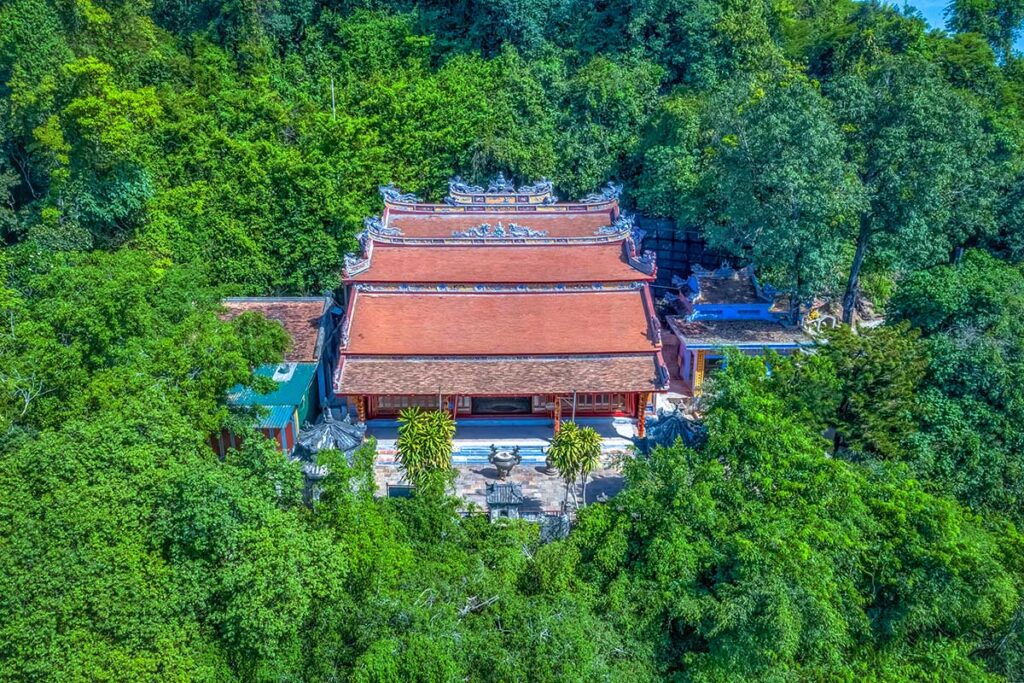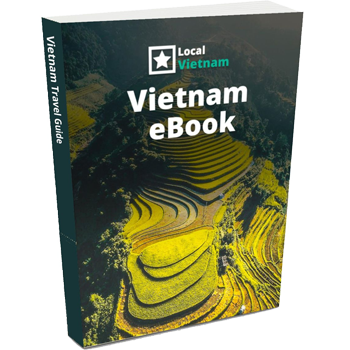What is the Hon Chen Temple?
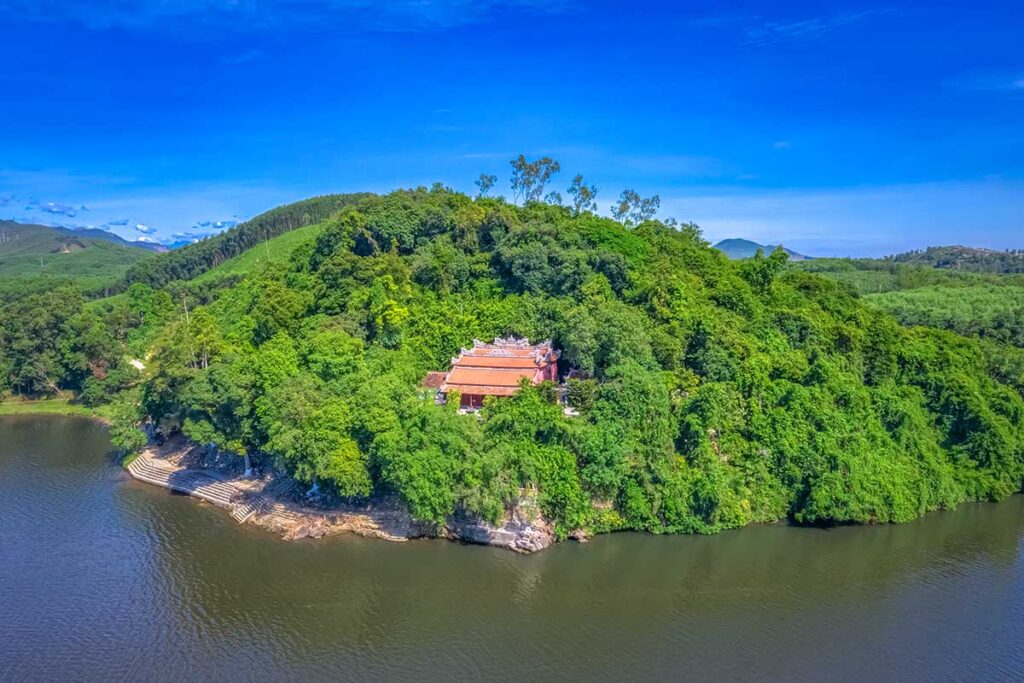
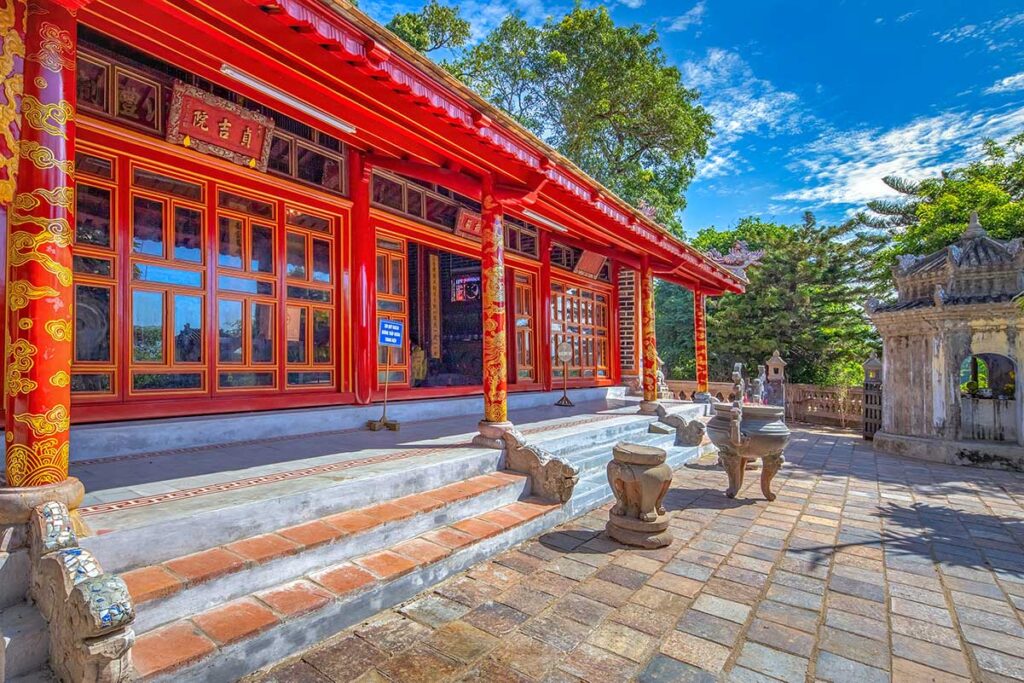
Hon Chen Temple—also referred to as the Hon Chen Shrine—is a riverside temple complex located on Ngoc Tran Mountain, right above the Perfume River about 8 kilometers from Hue. It’s known for its bright, colorful architecture and for blending elements of Buddhism, local folk beliefs, and royal rituals, especially those linked to the worship of the goddess Thien Y A Na. The temple may not be as grand as Hue’s imperial sites, but its unique atmosphere, hillside setting, and spiritual significance make it one of the more intriguing stops in the region.
History of Hon Chen Temple
The history of Hon Chen Temple goes back to the Nguyen Dynasty, though the site’s spiritual roots are even older. It is closely associated with the worship of Thien Y A Na, a goddess in Cham and Vietnamese folk religion who is believed to protect the land and bring prosperity. The site became a major religious center during the 19th century when Emperor Dong Khanh—a devoted follower of the goddess—sponsored renovations and officially recognized it as a royal temple.
Under Dong Khanh, royal ceremonies were held here to pray for national peace, good harvests, and protection. These rituals included processions on the Perfume River, linking Hon Chen Temple with the city’s royal and religious life. Though the temple fell into decline for a time, it has been gradually restored and continues to be used for spiritual festivals, especially the Hon Chen Festival, held twice a year with colorful boat parades and offerings.
Today, the temple remains a blend of local tradition and royal legacy—important to both religious practitioners and those interested in Vietnam’s cultural heritage.
A temple full of legends
Even the name “Hon Chen” is linked to local stories. One version says it comes from the mountain’s shape — Ngoc Tran, meaning “pearl bowl.” Another tells of Emperor Minh Mang accidentally dropping a jade cup into the river during a visit, only for a giant turtle to return it. Because of this, the temple was once called Hoan Chen (“Return the Bowl”). Later, after Emperor Dong Khanh’s coronation, it was renamed Hue Nam Dien (“Temple that brings favor to the southern king”) to honor the goddess Thien Y A Na, whom he believed helped him rise to power.
Highlights & architecture
Hon Chen Temple (also known as the Hon Chen Shrine) is built on the forested slope of Ngoc Tran Mountain, facing the Perfume River. Instead of a grand symmetrical layout like the royal tombs or pagodas in Hue, Hon Chen is a scattered complex of colorful temples and altars tucked into the hillside, partly hidden by trees. It feels more intimate and organic—almost like a spiritual village rather than a single monument.
The site blends folk religion, Buddhism, and royal traditions, and has long been a center for the worship of Thien Y A Na, the Mother Goddess of the land. As you walk between shrines, stone steps, and shaded terraces, you’ll find a mix of energy and calm that makes this place stand out among Hue’s religious sites.
1. Minh Kinh Dai – The main sanctuary
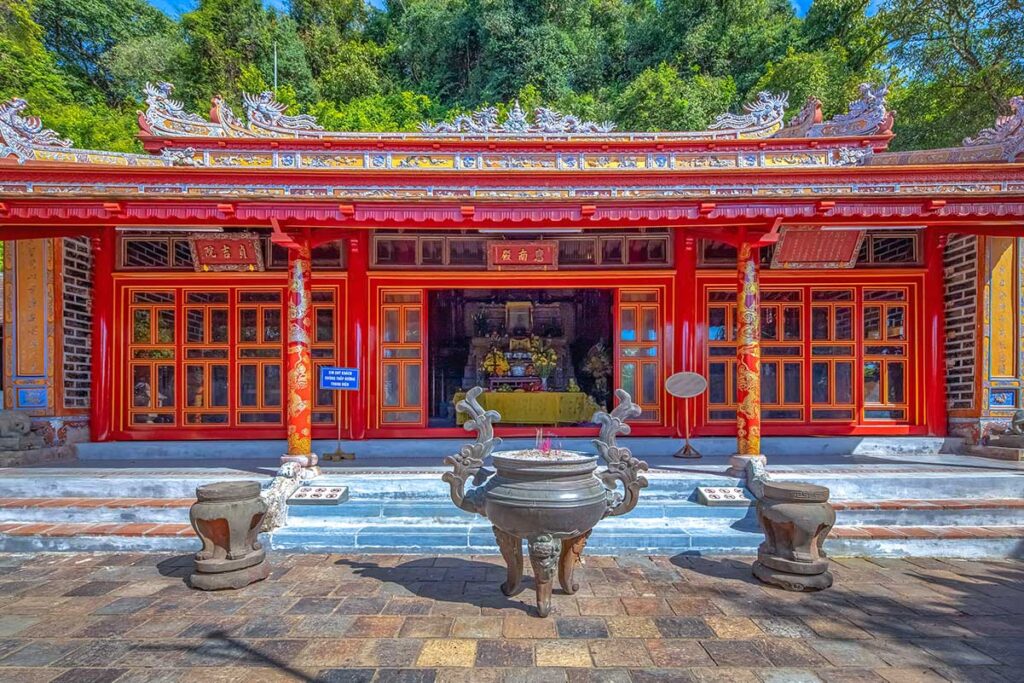
This is the heart of Hon Chen Temple and the most elaborate building on site. Minh Kinh Dai was rebuilt in 1886 by Emperor Dong Khanh and is divided into three levels:
- Minh Kinh Cao Dai (Upper Hall): Houses the main altar to Thien Y A Na, along with Princess Lieu Hanh, King Dong Khanh, and other high-ranking spirits.
- Minh Kinh Trung Dai (Middle Hall): A large ceremonial space used during festivals, often decorated with offerings, flags, and ritual objects.
- Minh Kinh Tieu Dai (Front Hall): Contains a large incense altar, along with drums and bells. This is the area most used by worshippers on a normal day.
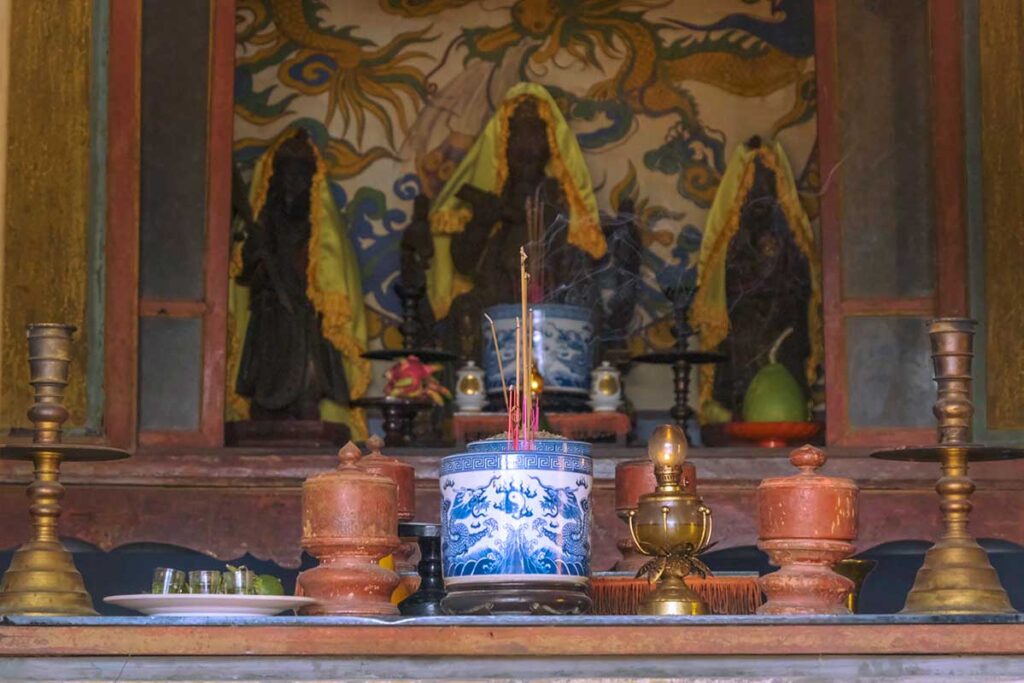
The building itself is colorful and richly decorated, with lots of phoenix imagery symbolizing feminine energy—fitting for a temple dedicated to a goddess. The roof and interior are covered with folk motifs, dragons, and vibrant ceramic tiles.
2. Smaller shrines and altars
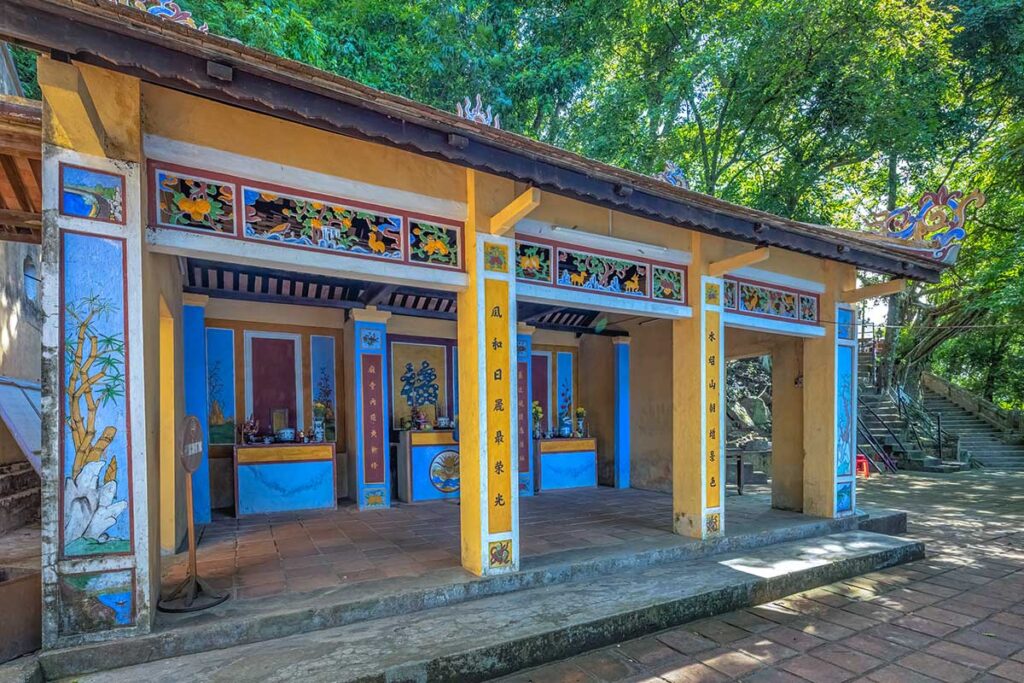
Surrounding the main sanctuary are about 10 smaller structures, each tucked into different corners of the slope. Some names travelers may come across include:
- Quan Cu House and Trinh Cat Vien (to the right of Minh Kinh Dai)
- Temple of the Five Saints and Altar of Mandarins (to the left)
- A shrine to the Tiger Spirit (also called Mr. Ha Ban), placed in a small forest cave
- Am Thuy Phu, Am Co Ngoc Lan, and Am Trung Thien – smaller hermit-like shrines scattered around the grounds
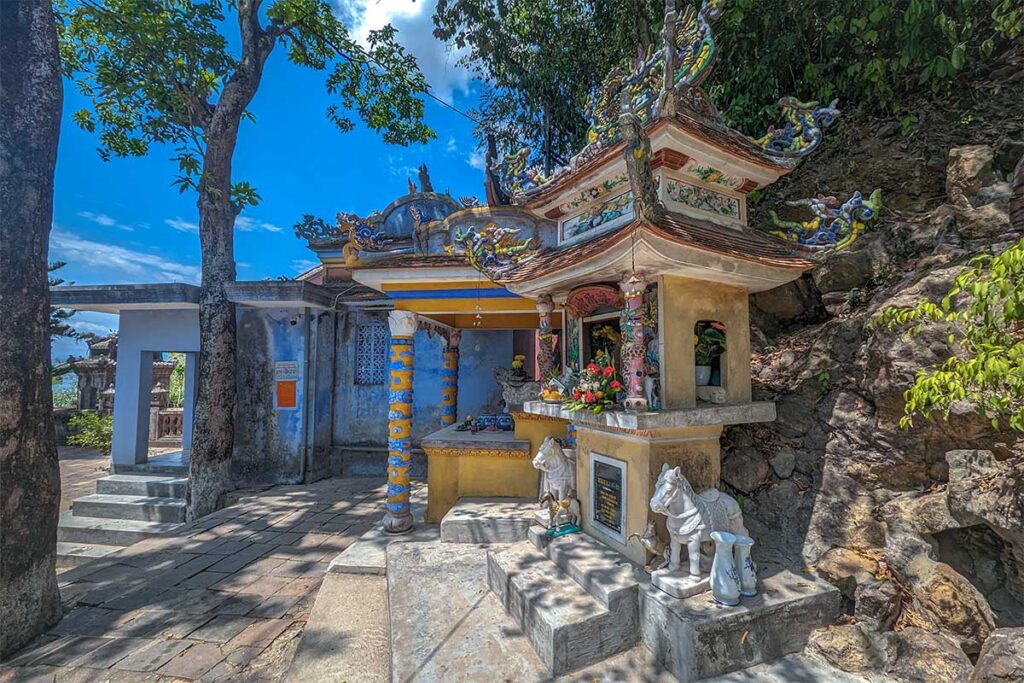
These buildings aren’t large, but they add character and variety to the visit. Walking between them gives the sense of a living spiritual landscape shaped over time.
3. Terrace and riverside view
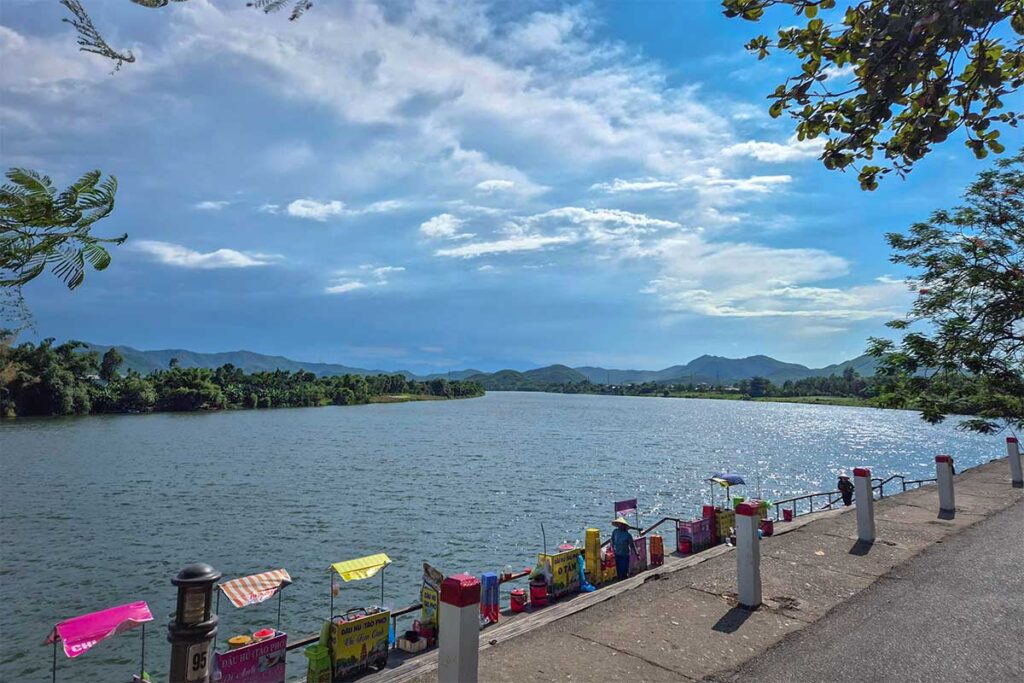
One of the most beautiful features of Hon Chen is its location. The main terrace overlooks the Perfume River, with trees framing the view and boats often passing below. During festivals, this spot becomes the landing area for ceremonial rafts and dragon boats. On a regular day, it’s a quiet place to sit and enjoy the breeze and scenery.
4. Colorful decorations and folk motifs
Unlike the muted tones of royal tombs, Hon Chen Temple is full of bright reds, golds, blues, and greens. Decorations mix Cham-inspired art, local folk symbols, and classic Vietnamese Buddhist details. You’ll see phoenixes, lotuses, dragons, and even natural stones incorporated into the walls. It reflects the temple’s diverse spiritual influences—from royal worship to Dao Mau, the Vietnamese Mother Goddess religion.
Hon Chen Festival
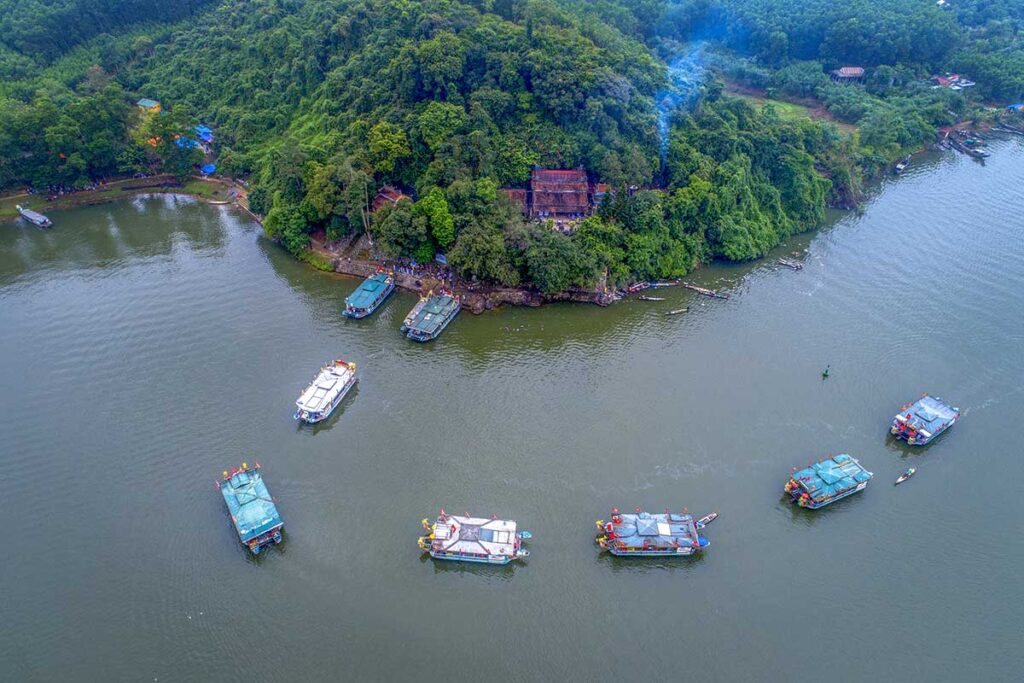
Twice a year—during the 3rd and 7th lunar months—Hon Chen Temple becomes the center of one of Hue’s most lively spiritual events: the Hon Chen Festival. The main highlight is the river procession, where decorated dragon boats carry offerings, music, and performers dressed in traditional costumes down the Perfume River. Rituals take place both on the water and inside the temple, with singing, dancing, and Dao Mau ceremonies honoring the Mother Goddess Thien Y A Na. Even if you’re not religious, it’s a unique way to experience a living folk tradition—loud, colorful, and full of symbolism.
Visiting information & Travel tips
Location
Hon Chen Temple is located on the slope of Ngoc Tran Mountain, about 8–10 km southwest of Hue’s city center, right along the Perfume River. The temple faces the water and is partly hidden by trees, giving it a quiet and almost mystical setting.
Opening hours
The site is usually open during daylight hours. There are no strict posted times, but visiting between 7:00 AM and 5:00 PM is best.
Entrance fee
Entrance is free, but donations are welcome. During the festival period, it can get crowded and slightly more structured.
Dress code
As with most religious sites in Vietnam, it’s best to dress modestly—cover shoulders and knees, and remove hats when entering shrine areas.
Best time to visit
If you’re not visiting during the festival, aim for morning or late afternoon, when the river is calm and the lighting is good for photos. The area is shaded and peaceful most of the day.
How to get to Hon Chen Temple
By Dragon Boat (Recommended)

The most memorable way to reach Hon Chen Shrine is by dragon boat from Hue city. Boats leave from Toa Kham Boat Station near the Imperial City and travel upstream on the Perfume River. The ride takes about 30–40 minutes and offers a scenic approach—you’ll spot the temple rising above the trees as you arrive.
By Taxi or Grab
You can also reach the temple by road, though it’s a bit less direct. A taxi or Grab from central Hue takes around 20–25 minutes and may cost around 100,000–150,000 VND. The last part of the drive is a small local road, so it’s good to set the exact pin location in your app.
By Motorbike
For more flexibility, renting a motorbike is a good option. Just follow Huyen Tran Cong Chua Street heading southwest out of the city, then look for signs pointing toward Ngoc Tran Mountain. There’s space to park near the temple entrance.
